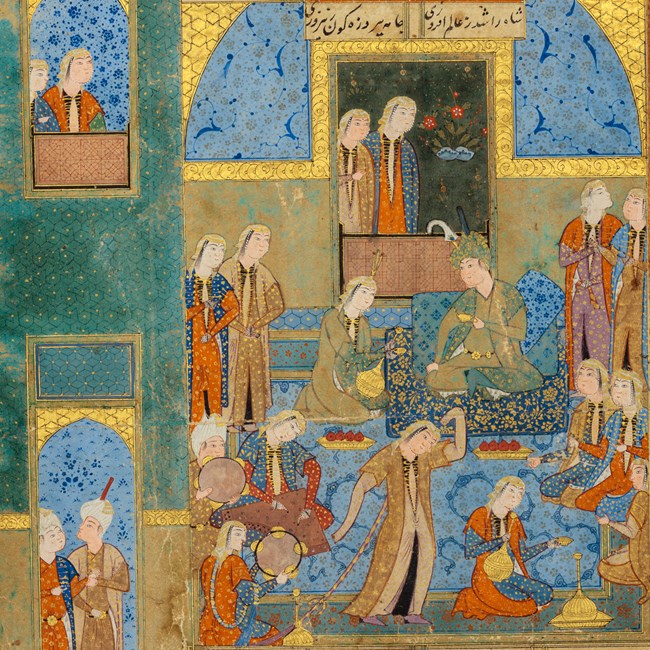
Bahram Gur visits the Turquoise Pavilion from Haft Peykar, from a manuscript of Khamsa of Nizami
Bahram Gur visits the Turquoise Pavilion from Haft Peykar, from a manuscript of Khamsa of Nizami
Bahram Gur visits the Turquoise Pavilion from Haft Peykar, from a manuscript of Khamsa of Nizami
Shiraz, Iran, c.1560-80
Opaque watercolor, ink, and gold on paper
29cm high, 19cm wide
Provenance: From the collection of a European family since mid-19th century.
Stock No.: A5300a
Bahram Gur visits the Turquoise Pavilion from Haft Peykar, from a manuscript of Khamsa of Nizami
This painting depicts an episode of the Haft Peykar, an epic romantic poem which is a part of a Khamsa (a collection of poems) from the renowned Persian poet, Nizami Ghanjavi (d.1209).
In the illustration, the Sasanian king Bahram Gur sits in an architectural setting of turquoise colour and is surrounded by courtly companions who are entertaining him with music and dancing. The main illustration is framed by verses above and below. The title of the illustration, written in white thuluth and illuminated with gold background, sits directly above the painting. It reads “raftan-i Bahrām rūz-i chahār-shanbi bi gonbad-i azraq (Bahram’s visit to the Turquoise Pavilion on Wednesday).” The turquoise dome of the pavilion is in the top margin of this folio, while onlookers in a turquoise building peep through a set of door and a window. This scene is finely illustrated and illuminated, as seen from the individualistic depictions of figures’ facial features and clothing, as well as the rich array of patterns on various surfaces of the building. The reverse side of the folio continues the verses from the illustrated page. The illuminated cartouche is inscribed with “qeṣe-guftan-e dukhtar (the girl’s story-telling),” which leads the reader onto the following portion of the story.
The Haft Peykar is an epic romantic poem that tells the story of the Sasanian king, Bahram Gur (ruled AD 420–38). Bahram Gur's architect constructed seven domed pavilions for each of his beautiful brides who came from different parts of the world. The architect tells him that each of the climes is ruled by one of the seven planets and advises him to assure his good fortune by adorning each dome with the colour associated with the clime and planet of its occupant. On each day of the week, the king visited one princess and enjoyed her company, and in turn, the princess would tell Bahram a moralistic story. In this scene depicting Wednesday (the day ruled by the planet Mercury), Bahram is accompanied by the bride from Maghrib who lives in the turquoise pavilion and is dressed in turquoise colour.
The high quality of the manuscript can be reflected in the illumination, calligraphy and the highly detailed illustration. They all point to a likely origin of a royal workshop from the early Safavid period.
The text on the painting page reads:
سرخ گل شاه بوستان نبود گر ز سرخی درو نشان نبود
چون به پایان شد این حکایت نغز گشت پر سرخ گل هوا را مغز
روی بهرام از آن گل افشانی سرخ شد چون رحیق ریحانی
چارشنبه که از شکوفه مهر گشت پیروزهگون سواد سپهر
شاه را شد ز عالم افروزی جامه پیروزهگون ز پیروزی
شد به پیروزه گنبد از سر ناز روز کوتاه بود و قصه دراز
زلف شب چون نقاب مشکین بست شه ز نقابی نقیبان رست
Reference:
Blois, François de. ‘HAFT PEYKAR’. In Encyclopedia Iranica, XI:522–24, 2002. https://iranicaonline.org/articles/haft-peykar.
Folios from the same manuscript are dispersed among American institutions:
Bahram Gur Visits the White Pavilion, Cleveland Museum of Art (2006.146);
Bahram Gur Visits the Black Pavilion, National Museum of Asian Art, Washington D.C (S1986.182);
Bahram Gur Visits the Yellow Pavilion, National Museum of Asian Art, Washington D.C (S1986.180).
@AMIRMOHTASHEMI









 instagram
instagram
